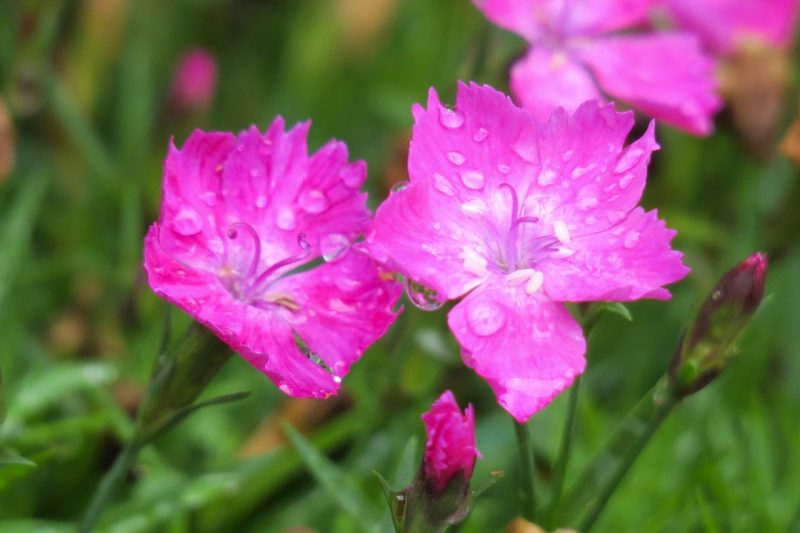Have you been trying to figure out how to trim dianthus the right way? This article will not only show you the steps that are involved in the process, but it will also give you a closer look at the plant itself.

What Is A Dianthus?
Dianthus happens to be a flowering plant of a specific genus that also includes pinks or carnations. You can expect this plant to produce incredibly reliable flowers during the summer season. Some of these plants can be annual while others are biennial or perennial.
Furthermore, you can usually spot dianthus cultivars them thriving well within USDA plant hardiness zones 3 to 9. There are over 300 varieties of dianthus flowers and these come in different sizes, shapes, and colors. This plant can grow in clumps and in terms of length, they can range between 6 inches to three feet and in most cases.
These plants produce bright green or gray-green leaves that are slender and fingerlike. Their stems are numerous and they bloom anytime between early summer through the fall season. If you’re planning to make cut flower arrangements, dianthus flowers won’t disappoint.
It’s best to plant new dianthus from seedlings that are stocky, compact, and strong. This will minimize their need for further trimming, as well as pinching.
In case you’re not aware, seedlings that are overgrown or leggy tend to take more time to recover once you transplant them. In fact, they won’t even flower at all even if you regularly trim them.
A Step-By-Step Guide On How To Trim Dianthus
The secret to keeping your dianthus plants blooming is by trimming and getting rid of spent flowers. Aside from encouraging your plants to rebloom, trimming them will also help you maintain health, as well as the shape of their stems and leaves.
It’s important to note that dianthus plants are able to tolerate even the most severe trims. After they’ve been severely trimmed, they tend to produce lusher foliage and more blooms. To help you achieve your desired results, follow this step-by-step guide on how to trim dianthus:
Step #1: Get rid of the fading dianthus flowers
The first thing you need to do is to pinch off the flowers that are starting to show signs of fading and wilting. In order to prevent seed formation, you need to get rid of the old flower head that you can find above the topmost set of leaves. This will help you increase your plant’s chances of reblooming.
Step #2: Cut back mounding varieties
Right after the completion of the first flush of flowering in early summer, make sure that you cut back mounding dianthus types. You need to get rid of up to half the height of the plant. Use a clean pair of pruning shears or scissors if you want to force your dianthus plant to produce more flower buds, as well as healthy and bushy growth.
Step #3: Pinch back the overgrown stems
If you spot any dianthus stem that looks leggy or overgrown, be sure to trim them or pinch them back only during the summer growing season. This helps your plant maintain its shape. Moreover, you can encourage branching if you decide to make cuts close to a leaf bud that’s on the stem.
Step #4: Prune them back in the fall
When your dianthus plants are beginning to naturally die back in the fall, you need to prune them back. You can do so by cutting each of the plants down up to 2 inches of the soil. Be sure to dispose of the removed foliage as well.
What are the Major Benefits of Growing Your Plants In A Semi Pro Greenhouse?
Anyone who wants to take their gardening experience to the next level would seriously consider investing in a semi pro greenhouse. If you want to take a closer look at how this would benefit you and your plants, check this out:
It protects your plants from bad weather conditions
One of the best things about having your own semi pro greenhouse is the fact that you won’t have to make emergency preparations in the event of a storm, blizzard, or other types of harsh weather conditions. The semi pro greenhouse serves as a protective covering that shields your plants from external elements.
It keeps the pests and vermin away
The last thing you want is to see all of your gardening efforts going down the drain after being attacked by destructive bugs and vermin. Thankfully, a semi pro greenhouse can also act as a barrier that keeps these pests at bay.
You can manipulate your plants’ growing conditions
The enclosed space of your semi pro greenhouse allows you to easily manipulate its internal temperature and humidity levels in order to perfectly suit your plants’ needs.
You can experience extended growing seasons
With a semi pro greenhouse, you can be free to tend to your plants and control the internal environment of the enclosed structure.
Final Thoughts
Learning how to trim dianthus is the first step. The next logical move would be to experience the benefits of greenhouse gardening. Don’t miss out on the benefits of growing your precious plants inside a semi pro greenhouse!
